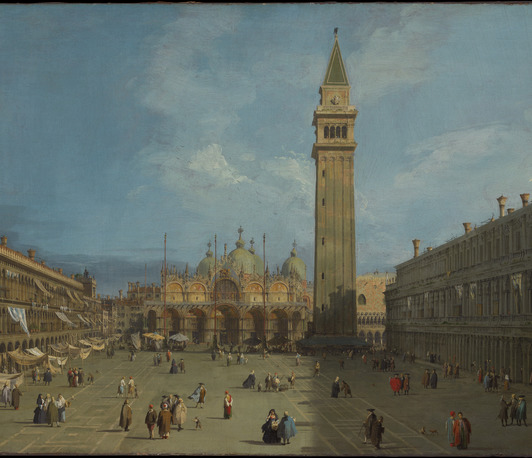Fabricating the City: Canaletto and 18th Century-Venice
Research Seminar
- Public event without registration
- Datum: 04.06.2024
- Uhrzeit: 11:00 - 13:00
- Vortragender: Basile Baudez
- Ort: Villino Stroganoff, Via Gregoriana 22, 00187 Rome and online
- Kontakt: mara.freiberg@biblhertz.it

One of the most famous cities in Europe and a gateway to the East, visited by merchants and tourists from around the world, Venice was adorned with textiles of all types: Turkish carpets, military standards, baldachins, and clothing, among them. Focusing on the celebrated vedute of Canaletto, this seminar will discuss how textiles mediated tensions between public authorities and private citizens in the control of common spaces such as streets and squares just as distinct public and private spheres were emerging in Europe and the question of who controlled them became increasingly contentious. Eighteenth-century Venice emerges here as a vivid case study for the progressive transformation of streets and squares from sites of living to sites of regulated circulation and temporary occupation, a marker of modern cities as we know them. By exploring the rich and varied textiles that adorned one of the most beautiful cities in Europe, this research seminar will not only shed light on a key moment in Venice’s political and artistic history, it will provide valuable historical grounding for future discussions about the role of physical fabrics in the social and political fabric of our cities.
This research looks at eighteenth-century Venice to establish a model applicable to any urban context. Under the pressure of the contemporary explosion of the tourist market in the eighteenth century, Venice became the most reproduced and recognizable cityscape in the world, far more so than urban centers like Paris and London. Images of the city and its inhabitants are found in painting, print, drawing, porcelain, and furniture while being endlessly described in travel books, guides, letters, novels, and plays. An entire school of city view painters celebrated its contemporary life in contrast to the ruins of Rome, its main rival. Having lost its economic and political standing on the world stage, the Venetian Republic positioned itself as a unique space of political stability, freedom, and pleasure while celebrating its cosmopolitanism. Indeed, Venice kept its unique status as the main trade partner of the Ottoman Empire, and its tourists sought to get a glance at its exotic visitors and their luxurious fabrics. Recent historiography on Venice has challenged the traditional view of the eighteenth century as a time of decadence and backwardness; in fact, it enjoyed an era of financial prosperity (derived largely from the textile industry), intellectual, musical, and artistic renaissance that posits the city, with its unique republican government, as a perfect case study to tell a story about modernity.
St Mark’s Square, the center of Venetian political, religious, and social life, was the most tightly controlled space in the Republic and probably in the whole of Europe. It is the heart of this study and is often compared to the stage of a theater, to which seeing and being seen are integral. On the Venetian stage, the Republic’s Senate took painstaking care to regulate the usage of and access to its every part, from the porticoes under the Procuratie to the interstitial space between the two Piazzetta granite columns: beggars and prostitutes were forbidden, itinerant vendors had to be authorized, garments were carefully controlled. But the Square was also the main locus of distraction, encounters, gossip, the location of the most popular cafés like Florian and luxury shops. On St Mark’s Square the Senate organized the main religious and civic festivities from the annual, tented Corpus Domini procession to the vast ephemeral luxury market erected the week of the Ascension – and, of course, the most famous Carnival of the continent, where clothes and masks helped to disguise each participant. By focusing on images, testimonies, and laws governing St Mark’s Square, this research covers the entirety of urban life in its spatial and temporal complexity through the textile medium.
Basile Baudez is Associate Professor of Architectural History in the Art & Archaeology department at Princeton University after having taught at the Sorbonne in Paris. His first book, Architecture et Tradition Académique au Siècle des Lumières (Presses Universitaires de Rennes, 2013) questions the role of architects in early modern European academies. He co-edited several volumes on the history of architecture such as A Civic Utopia. Architecture and the City in France, 1765-1837 (Drawing Matters, 2016), Chalgrin et son Temps. Architectes et architecture entre l’Ancien Régime et l’Empire (Blake and Co, 2016) and most recently Textile in Architecture from the Middle Ages to Modernism (Routledge, 2023). He curated several shows devoted to architectural drawings, at the Ecole des Beaux-Arts and at the Musée des Arts Décoratifs in Paris, and at the Courtauld Institute in London. His latest monograph, Inessential Colors: Architecture on Paper in Early Modern Europe (Princeton University Press, 2021) was the 2022 winner of the Alice Davis Hitchcock Medallion awarded by the Society of Architectural Historians of Great Britain. He is currently completing a book project entitled Textiles in the City: Fabricating Eighteenth-Century-Venice on the role of textiles in urban settings.
This event can be followed also ONLINE on our VIMEO CHANNEL. The link will be soon published HERE.
Scientific Organization: Anna Dumont